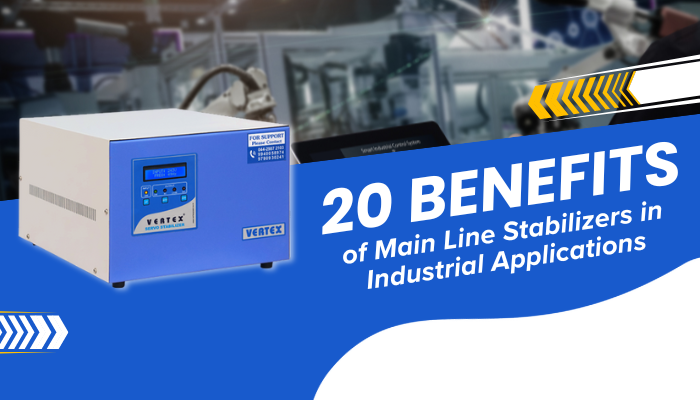In industrial settings, consistent power supply is not just a requirement; it’s a critical component of daily operations. Voltage fluctuations are a common challenge, particularly detrimental in industries where precision and efficiency are paramount. A main line stabilizer can be a game changer by ensuring stable voltage levels.
This blog will explain the top 20 benefits of installing a main line stabilizer in industrial settings, highlighting why it’s an essential investment for any industrial operation.
- Enhanced Equipment Protection: Voltage stabilizers shield sensitive industrial machinery from harmful voltage spikes, preventing breakdowns and extending the operational reliability of these crucial assets.
- Reduced Downtime: Consistent voltage delivery minimizes unexpected equipment failures, thus avoiding costly production halts and ensuring continuous industrial operation without interruptions.
- Increased Productivity: Stable power conditions enable machinery to operate at peak efficiency, boosting output rates and streamlining production processes for enhanced industrial productivity.
- Improved Safety: Voltage stabilizers help prevent electrical accidents and malfunctions, significantly increasing workplace safety for operators and sensitive electronic equipment alike.
- Energy Savings: With precise voltage control, stabilizers reduce excess power consumption, lowering energy bills and contributing to more sustainable industrial practices.
- Lower Maintenance Costs: Regular voltage levels decrease wear and tear on machinery, leading to less frequent repairs, lower maintenance costs, and reduced lifecycle expenses.
- Extended Equipment Lifespan: Stabilising voltage fluctuations extends the durability of industrial machinery by avoiding stress caused by over or under-voltage conditions.
- Better Quality Control: Reliable power ensures consistent operational conditions, crucial for maintaining high-quality production standards and reducing variability in output.
- Compliance with Industry Standards: Main line stabilizers ensure adherence to stringent industry regulations regarding power quality, helping facilities avoid legal and compliance issues.
- Minimized Electrical Noise: Reducing electrical noise enhances the performance of sensitive electronic equipment, crucial in quality control and precision manufacturing environments.
- Scalability: Voltage stabilizers can be adapted and scaled to accommodate increases in electrical demand as industrial operations expand, providing flexibility in capacity planning.
- Enhanced Resilience to Power Surges: They buffer and mitigate the effects of sudden external power surges, protecting equipment from potential damage and failure.
- Support for Heavy Machinery: Heavy machinery benefits from the continuous and stable power supply provided by stabilizers, ensuring safe and efficient operation.
- Reduction in Phase Imbalance: They help maintain balance across electrical phases, reducing wear on motors and preventing efficiency losses in three-phase systems.
- Improved Power Factor: Some stabilizers enhance the power factor of the electrical system, improving overall electrical distribution efficiency and reducing strain on infrastructure.
- Reliable Computer and Data Operations: Ensuring consistent power protects against data corruption and loss, essential in industries relying on digital processes and data storage.
- Smoother Start-Up: Stabilizers manage voltage during machine start-ups, reducing mechanical stress and enhancing the longevity of industrial equipment.
- Fewer Faults in Electrical Systems: Voltage stability reduces the frequency of electrical faults, leading to fewer disruptions and lower chances of component failure.
- Optimised Electrical Environment: A stable power supply creates an optimised electrical environment, fostering a more efficient and reliable industrial operation.
- 20. Peace of Mind: Industrial managers gain confidence knowing that power issues are controlled, allowing them to focus more on productivity and less on operational risks.
Application of Mainline Stabilizer in Industrial Settings:
The application of a mainline stabilizer is crucial for ensuring continuous and stable operation. These stabilizers play a pivotal role in regulating the voltage supply across extensive facilities, preventing the kind of voltage fluctuations that can lead to equipment damage, production downtime, and safety hazards.
For instance, in manufacturing plants that use heavy-duty electrical machinery, even a minor inconsistency in power quality can result in significant production losses and increased maintenance costs.
By providing a constant and reliable power supply, mainline stabilizers ensure that these machines operate within their optimal voltage range, enhancing overall efficiency and productivity.
They are particularly valuable in sectors such as
Pharmaceuticals,
Automotive manufacturing,
and food processing,
where precision and reliability are key to maintaining production standards and meeting compliance requirements.
The mainline stabilizer’s ability to shield industrial systems from electrical disturbances also extends the lifespan of the equipment, reducing the need for frequent replacements and repairs,
Thus offering a cost-effective solution to manage industrial power demands efficiently.
Conclusion:
The installation of a main line stabilizer in an industrial setting is not just about protecting equipment; it’s about transforming the operational landscape.
From enhancing productivity to ensuring compliance with safety standards, the benefits are profound and far-reaching. Investing in a reliable main line stabilizer is a strategic decision that secures the operational backbone of any industry, safeguarding its assets and future.
Particularly in India, where power fluctuations are frequent and often severe, integrating a servo voltage stabilizer in India with mainline capabilities is essential.
This combination ensures that industries operate smoothly, maintaining high standards of efficiency and reliability while protecting against the unique challenges posed by the local power supply.


